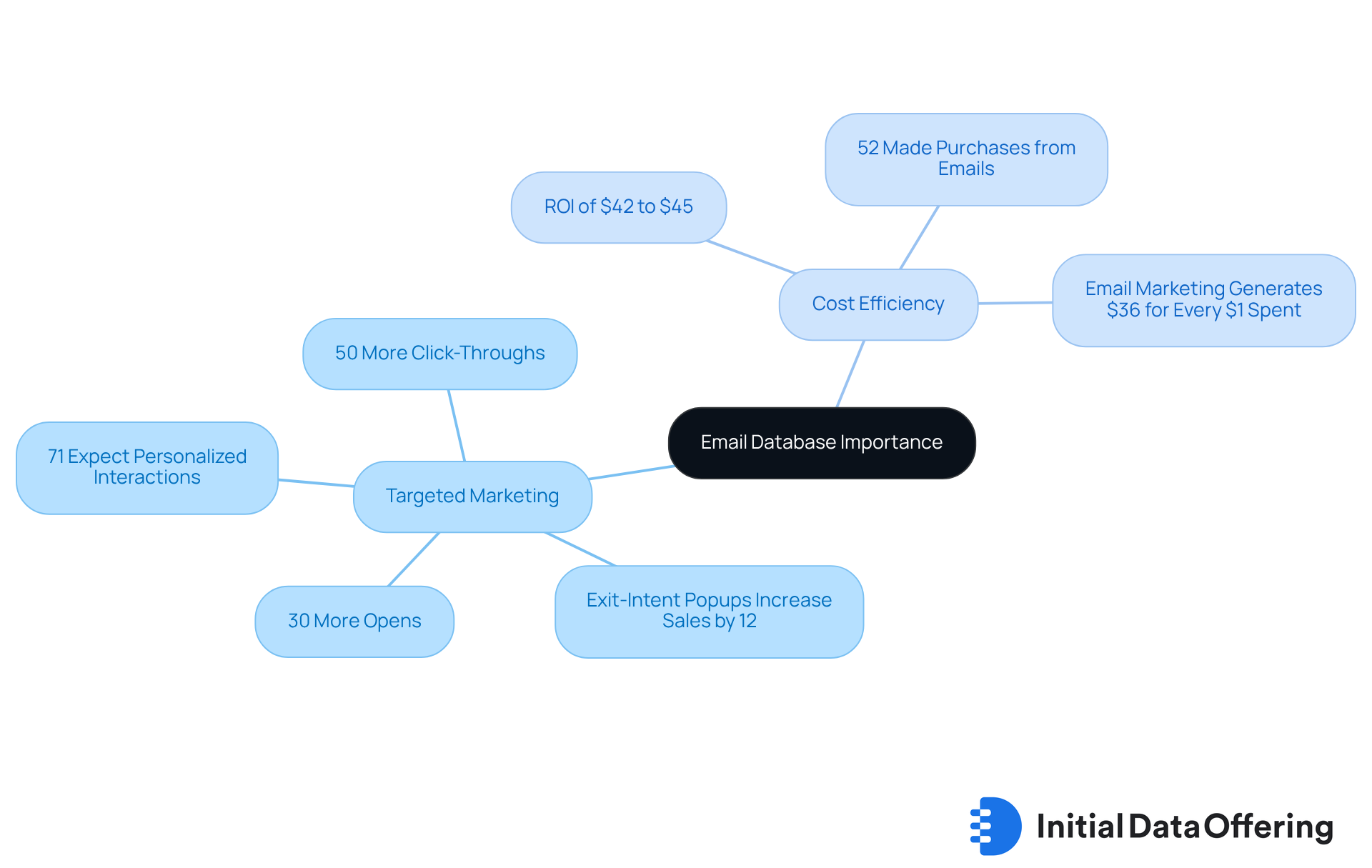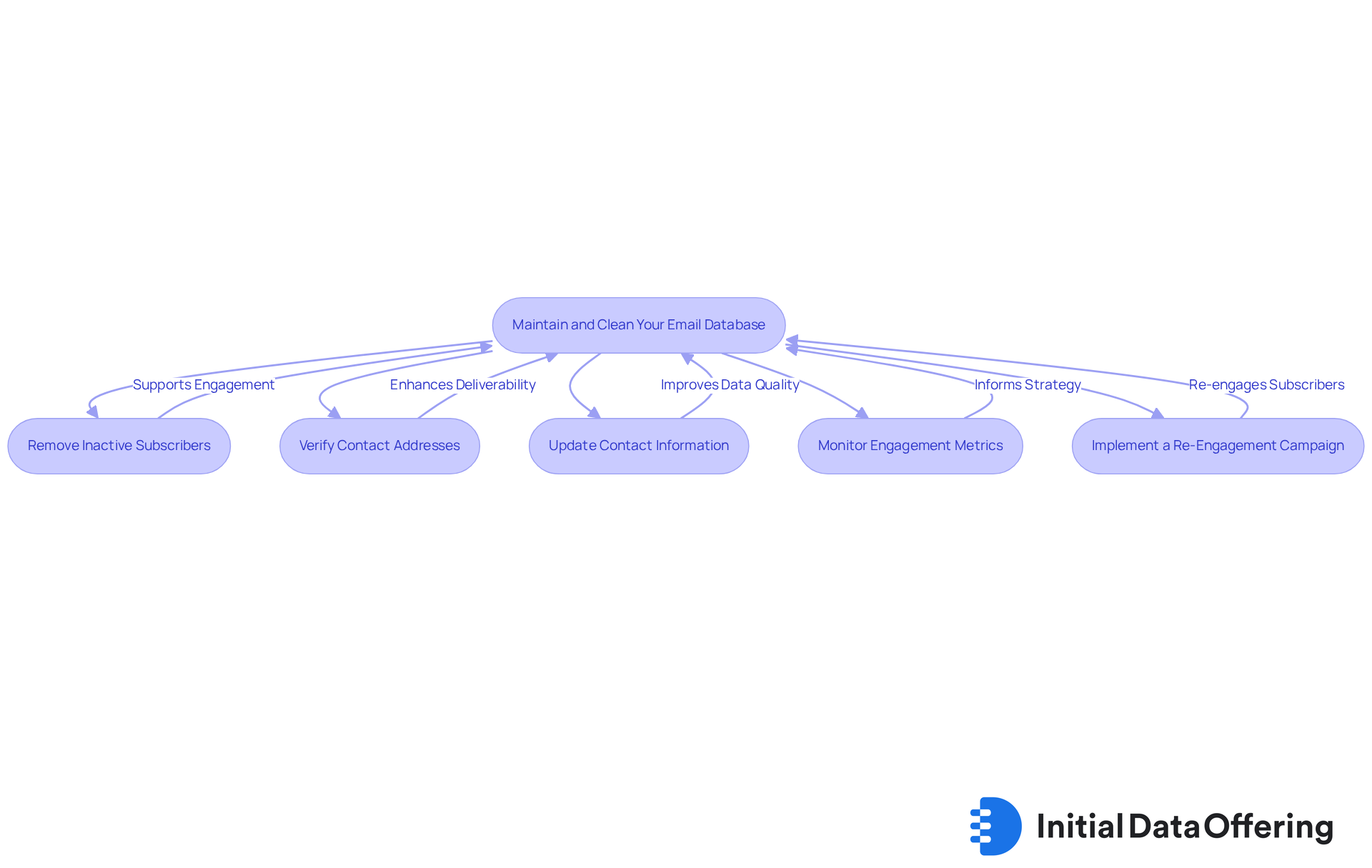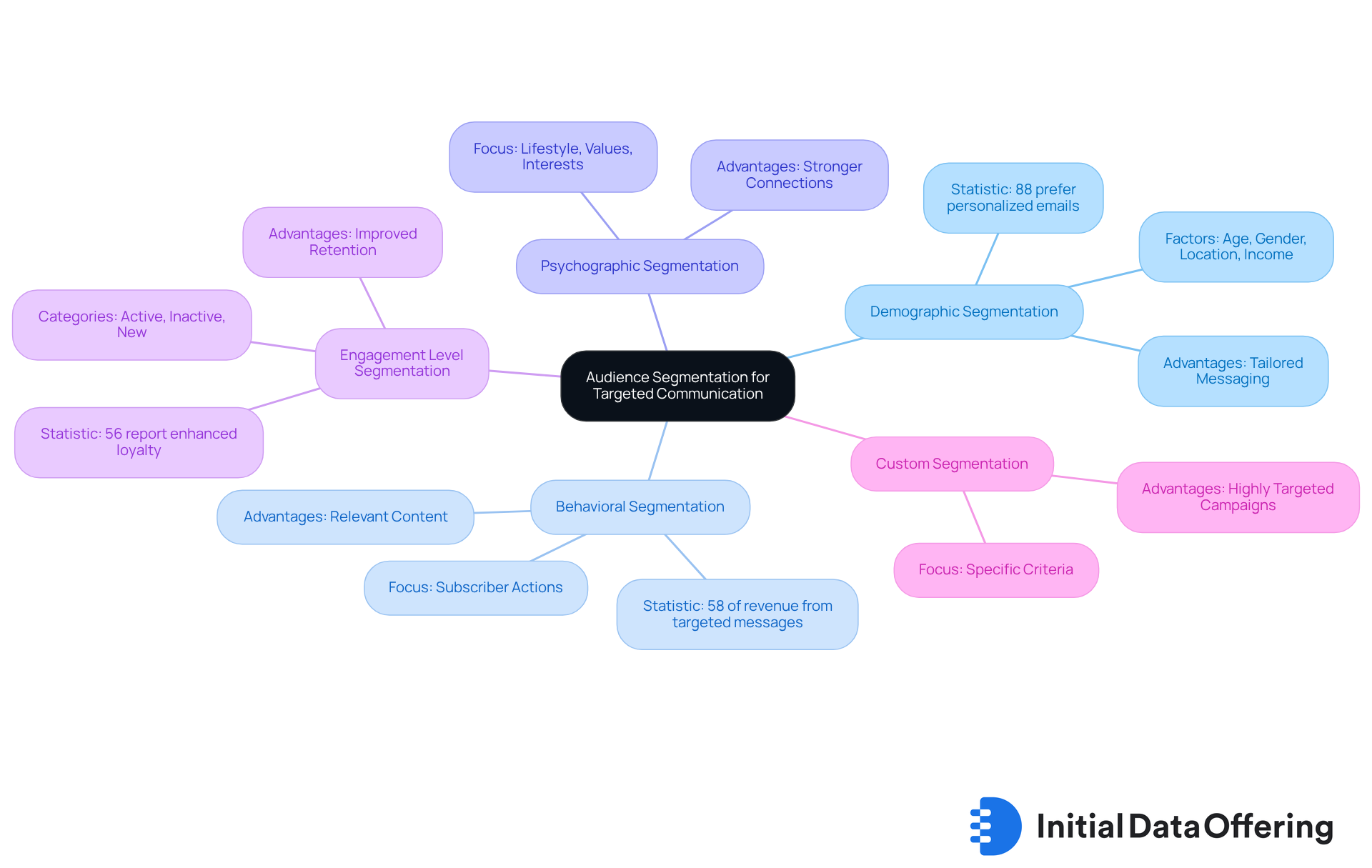Build Your Email Database: 4 Steps for Market Research Success

Build Your Email Database: 4 Steps for Market Research Success
Overview
The article emphasizes the significance of building an email database as a cornerstone for successful market research. It details essential strategies, including the collection of email addresses, database maintenance, and audience segmentation. These strategies are backed by compelling statistics that illustrate how such practices can boost customer engagement and enhance marketing ROI.
Why is an email database crucial? First, it allows businesses to reach their audience directly, fostering a more personal connection. Second, maintaining this database ensures that the information remains current and relevant, which is vital for effective communication. Finally, segmenting the audience enables targeted marketing efforts, leading to improved response rates and customer satisfaction.
Incorporating these practices not only increases engagement but also maximizes the return on investment in marketing efforts. By understanding and implementing these strategies, businesses can position themselves for greater success in their marketing initiatives.
Introduction
Building an effective email database is a cornerstone of successful marketing strategies, enabling businesses to connect meaningfully with their target audiences. A well-organized database allows companies to harness the power of personalized communication, significantly enhancing customer engagement and driving conversion rates. However, the challenge lies not only in collecting these valuable email addresses but also in maintaining their relevance and effectiveness over time.
How can businesses ensure that their email marketing efforts yield the highest return on investment while navigating the complexities of audience segmentation and database management?
Define Your Email Database and Its Importance
A meticulously organized email database of electronic addresses and associated details serves as a crucial instrument for effective communication with your target group. Its significance in marketing cannot be overstated, as it enables targeted campaigns that can dramatically improve customer engagement and conversion rates. Here are key aspects of a well-defined email database:
- Targeted Marketing: A robust email database facilitates segmentation, allowing businesses to tailor their communications to resonate with specific audience segments. This personalization is crucial, as 71% of consumers expect personalized interactions from brands, and 80% are more likely to engage with companies that do so. Furthermore, utilizing exit-intent popups can result in an immediate 12% increase in boosting sales. How can you leverage your contact lists to enhance customer interaction? Analyzing the data within your email database provides invaluable insights into customer behavior and preferences. This information can direct promotional strategies, ensuring they align with audience needs and interests. For instance, businesses that leverage customer insights often see a significant increase in engagement metrics, with segmented campaigns yielding 50% more click-throughs and 30% more opens. Additionally, messages stay in a user's inbox until interacted with, unlike social posts that vanish within hours, offering extended exposure for promotional content. Are you maximizing the potential of your customer insights?
- Cost Efficiency: Email promotion is recognized for its cost-effectiveness, delivering an average ROI of $42 to $45 for every dollar spent. This renders a a vital resource for companies of every scale, enabling them to optimize their promotional expenditures while attaining significant returns. Notably, 52% of consumers made a purchase directly from a message in the last year, further highlighting the effectiveness of marketing through this medium. How can you ensure your email marketing strategy is cost-effective?
Grasping the significance of an organized communication repository is the essential step toward utilizing its potential for market research success. Furthermore, with mobile accesses representing 81% of all message openings, optimizing for mobile is essential to guarantee that your communications reach your audience effectively.

Collect Email Addresses Effectively
To create a strong email database, it is essential to implement effective strategies for gathering addresses. Here are some proven methods:
- Create Compelling Sign-Up Forms: Place sign-up forms prominently on your website, ensuring they are easy to fill out. Clear calls-to-action (CTAs) encourage visitors to subscribe. Notably, statistics indicate that using 'my' in CTAs can increase click-through rates by 90%, making your CTAs more engaging and effective.
- Offer Incentives: Providing value in exchange for contact addresses is crucial. This could take the shape of discounts, free trials, or exclusive content that attracts your intended audience. When potential subscribers perceive tangible benefits, they are significantly more likely to engage, resulting in increased sign-up rates.
- Utilize Social Media: Promoting your sign-up forms on social media platforms can be highly effective. Engaging with your audience and encouraging them to subscribe for updates and special offers is key. Adding testimonials or subscriber counts to your forms can enhance conversions by as much as 15%, reinforcing the value of joining your list.
- Host Webinars or Events: Gathering contact addresses during registration for webinars or events not only builds your information repository but also fosters a connection with potential customers, enhancing their interaction with your brand.
- Utilize Content Marketing: Developing valuable material such as eBooks, whitepapers, or guides that require a contact address for access positions your brand as a thought leader. Users are often willing to exchange their information for high-quality content. Additionally, maintaining list hygiene is crucial for successful outreach, ensuring that your subscriber roster remains healthy and engaged.
By employing these strategies, you can effectively gather contact addresses to build your email database and establish a solid foundation for your marketing efforts.

Maintain and Clean Your Email Database Regularly
Maintaining and cleaning your email database is essential for maximizing its effectiveness. To achieve this, consider the following key practices:
- Regularly Remove Inactive Subscribers: Identify and eliminate contacts who have not interacted with your messages over the past 6 to 12 months. This practice not only enhances your open rates but also protects your sender reputation, as a clean list reduces bounce rates and improves deliverability. As Jesse Sumrak observes, "A smaller, more involved audience is significantly more valuable, resulting in higher conversion rates and an improved ROI for your marketing campaigns."
- Verify Contact Addresses: Utilize to ensure the validity of addresses in your database. Sending messages to invalid addresses can significantly harm your deliverability, making it essential to regularly check for and eliminate these entries. Regular cleaning of the email database can help reduce bounce rates, which experts recommend keeping under 0.5% to maintain sender reputation.
- Update Contact Information: Encourage subscribers to keep their information current. This can be achieved through periodic surveys or during special promotions, ensuring that your database reflects accurate and relevant data. Interacting with your viewers can lead to better data quality and enhanced marketing results.
- Monitor Engagement Metrics: Regularly track engagement metrics such as open rates and click-through rates. Low engagement levels may suggest that your content is not connecting with your audience, indicating a need for adjustments in your communication strategy. According to a case study on Social Media Examiner's subscriber list growth, effective strategies can significantly improve engagement rates.
- Implement a Re-Engagement Campaign: For subscribers who have not engaged with your messages, consider launching a re-engagement campaign. This can involve offering incentives or soliciting feedback to better understand their preferences and rekindle their interest. Executing a re-engagement campaign can assist in keeping subscribers before eliminating them from the list, ultimately enhancing your ROI, which is estimated at $36 for every $1 invested.
By following these practices, you can maintain a clean and efficient email database that supports your marketing goals, ultimately resulting in enhanced engagement and greater ROI.

Segment Your Audience for Targeted Communication
Dividing your demographic is essential for providing focused communication that resonates with specific groups. Here’s how to effectively segment your email database:
- Demographic Segmentation: This involves dividing your audience based on factors such as age, gender, location, and income. The advantage of this approach is that it allows you to tailor your messaging to various demographic groups, enhancing relevance and engagement. Research indicates that 88% of users favor messages customized to their interests, and 81% of shoppers are more inclined to buy from brands that provide personalized experiences. Thus, leveraging demographic insights becomes essential for effective communication.
- Behavioral Segmentation: This strategy examines subscriber actions, including prior purchases and interactions with past communications. By doing so, you can send relevant content aligned with their interests and actions, significantly boosting engagement rates. In fact, targeted messages through behavioral segmentation can account for up to 58% of total revenue, demonstrating its impact on business outcomes.
- Psychographic Segmentation: This approach considers the lifestyle, values, and interests of your target group. Understanding these deeper aspects allows for that resonates with their preferences, fostering stronger connections and loyalty among your audience.
- Engagement Level Segmentation: Here, you categorize subscribers based on their engagement levels—active, inactive, or new subscribers. Tailoring your communication strategy according to these categories can lead to improved retention rates. Notably, 56% of businesses utilizing segmentation report enhanced customer loyalty, underscoring the importance of ongoing management in segmentation efforts.
- Custom Segmentation: This involves creating segments based on specific criteria relevant to your business, such as product preferences or customer journey stages. The benefit of this approach is that it allows for highly targeted campaigns that address unique needs, ensuring your messages are both timely and relevant.
By implementing these segmentation strategies, you can significantly enhance your efforts with the email database for marketing. This ensures that your messages reach the right audience with the right content, ultimately driving better engagement and conversion rates. As one expert noted, "At the end of the day, segmentation isn’t about data. It’s about respect.

Conclusion
A well-structured email database is indispensable for businesses aiming to enhance their marketing strategies and foster meaningful connections with their audience. By effectively gathering, maintaining, and segmenting email addresses, companies can leverage personalized communication to significantly boost engagement and conversion rates.
This article outlines essential steps for building a successful email database. It highlights the importance of targeted marketing, cost efficiency, and the necessity of regular maintenance. Key strategies include:
- Creating compelling sign-up forms
- Offering incentives
- Utilizing various platforms for collection
Additionally, the significance of audience segmentation is emphasized, showcasing how tailored messaging can lead to improved customer loyalty and higher revenue.
Ultimately, the journey of building and managing an email database is not just about collecting addresses; it’s about nurturing relationships and delivering value to subscribers. Embracing these practices can transform email marketing into a powerful tool for business growth. By prioritizing a clean, well-segmented database, organizations can ensure that their marketing efforts resonate with their audience, driving engagement and fostering long-term success.
Frequently Asked Questions
What is an email database, and why is it important?
An email database is a meticulously organized collection of electronic addresses and associated details that serves as a crucial tool for effective communication with a target group. Its importance in marketing lies in enabling targeted campaigns that can significantly enhance customer engagement and conversion rates.
How does an email database facilitate targeted marketing?
A robust email database allows businesses to segment their audience, enabling personalized communications that resonate with specific groups. This personalization is essential, as 71% of consumers expect personalized interactions, and 80% are more likely to engage with brands that provide them.
What impact does analyzing data within an email database have on marketing strategies?
Analyzing the data in an email database provides insights into customer behavior and preferences, which can inform promotional strategies. Businesses that leverage these insights often see increased engagement metrics, with segmented campaigns yielding 50% more click-throughs and 30% more opens.
What is the cost efficiency of email marketing?
Email marketing is known for its cost-effectiveness, delivering an average ROI of $42 to $45 for every dollar spent. This makes a well-maintained email database a vital resource for companies, allowing them to optimize promotional expenditures while achieving significant returns.
How prevalent is mobile access for email communications?
Mobile access accounts for 81% of all message openings, highlighting the importance of optimizing email communications for mobile devices to ensure effective reach to the audience.
What percentage of consumers made a purchase directly from an email in the last year?
52% of consumers reported making a purchase directly from a message in the last year, underscoring the effectiveness of email marketing.